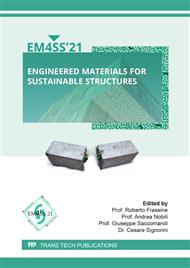[1]
A. Remennikov, S. Kaewunruen, Impact resistance of reinforced concrete columns: experimental studies and design considerations.
Google Scholar
[2]
D.-Y. Yoo, N. Banthia, Impact resistance of fiber-reinforced concrete-a review, Cement and Concrete Composites 104 (2019) 103389.
DOI: 10.1016/j.cemconcomp.2019.103389
Google Scholar
[3]
J. Thomas, A. Ramaswamy, Mechanical properties of steel fiber-reinforced concrete, Journal of materials in civil engineering 19 (5) (2007) 385-392.
DOI: 10.1061/(asce)0899-1561(2007)19:5(385)
Google Scholar
[4]
D.-Y. Yoo, Y.-S. Yoon, Influence of steel fibers and fiber-reinforced polymers on the impact resistance of one-way concrete slabs, Journal of Composite Materials 48 (6) (2014) 695-706.
DOI: 10.1177/0021998313477167
Google Scholar
[5]
D.-Y. Yoo, U. Gohil, T. Gries, Y.-S. Yoon, Comparative low-velocity impact response of textilereinforced concrete and steel-fiber-reinforced concrete beams, Journal of Composite Materials 50 (17) (2016) 2421-2431.
DOI: 10.1177/0021998315604039
Google Scholar
[6]
V. Mechtcherine, O. Millon, M. Butler, K. Thoma, Mechanical behaviour of strain hardening cement-based composites under impact loading, Cement and Concrete Composites 33 (1) (2011) 1-11.
DOI: 10.1016/j.cemconcomp.2010.09.018
Google Scholar
[7]
I. Curosu, V. Mechtcherine, D. Forni, E. Cadoni, Performance of various strain-hardening cement-based composites (shcc) subject to uniaxial impact tensile loading, Cement and Concrete Research 102 (2017) 16-28.
DOI: 10.1016/j.cemconres.2017.08.008
Google Scholar
[8]
L. Lanzoni, A. Nobili, A. M. Tarantino, Performance evaluation of a polypropylene-based drawwired fibre for concrete structures, Construction and Building Materials 28 (1) (2012) 798-806.
DOI: 10.1016/j.conbuildmat.2011.10.017
Google Scholar
[9]
E. Radi, P. Di Maida, Analytical solution for ductile and frc plates on elastic ground loaded on a small circular area, Journal of Mechanics of Materials and Structures 9 (3) (2014) 313-331.
DOI: 10.2140/jomms.2014.9.313
Google Scholar
[10]
L. Lanzoni, A. Nobili, E. Radi, A. Sorzia, Failure mechanism of FRC slabs on non-local ground, Meccanica 51 (10) (2016) 2473-2492.
DOI: 10.1007/s11012-016-0382-6
Google Scholar
[11]
L.-f. Liu, P.-m. Wang, X.-j. Yang, Effects of characteristics of polypropylene fiber on anti-dryshrinkage cracking property of cement mortar, Journal of Building Materials 3.
Google Scholar
[12]
F. Fraternali, V. Ciancia, R. Chechile, G. Rizzano, L. Feo, L. Incarnato, Experimental study of the thermo-mechanical properties of recycled pet fiber-reinforced concrete, Composite Structures 93 (9) (2011) 2368-2374.[13] C. Signorini, V. Volpini, Mechanical performance of fiber reinforced cement composites including fully-recycled plastic fibers, Fibers 9 (3) (2021) 16.
DOI: 10.1016/j.compstruct.2011.03.025
Google Scholar
[14]
X. Dong, Y. Ding, T. Wang, Spalling and mechanical properties of fiber reinforced highperformance concrete subjected to fire, Journal of Wuhan University of Technology-Mater. Sci. Ed. 23 (5) (2008) 743-749.
DOI: 10.1007/s11595-007-5743-5
Google Scholar
[15]
P. Di Maida, E. Radi, C. Sciancalepore, F. Bondioli, Pullout behavior of polypropylene macrosynthetic fibers treated with nano-silica, Construction and Building Materials 82 (2015) 39-44.
DOI: 10.1016/j.conbuildmat.2015.02.047
Google Scholar
[16]
P. Di Maida, C. Sciancalepore, E. Radi, F. Bondioli, Effects of nano-silica treatment on the flexural post cracking behaviour of polypropylene macro-synthetic fibre reinforced concrete, Mechanics Research Communications 88 (2018) 12-18.
DOI: 10.1016/j.mechrescom.2018.01.004
Google Scholar
[17]
C. Signorini, A. Sola, B. Malchiodi, A. Nobili, A. Gatto, Failure mechanism of silica coated polypropylene fibres for fibre reinforced concrete (FRC), Construction and Building Materials 236 (2020) 117549.
DOI: 10.1016/j.conbuildmat.2019.117549
Google Scholar
[18]
B. Felekoglu, K. Tosun, B. Baradan, A comparative study on the flexural performance of plasma treated polypropylene fiber reinforced cementitious composites, Journal of Materials Processing Technology 209 (11) (2009) 5133-5144.
DOI: 10.1016/j.jmatprotec.2009.02.015
Google Scholar
[19]
C. Signorini, A. Sola, B. Malchiodi, A. Nobili, Highly dissipative fiber-reinforced concrete for structural screeds, Journal of Materials in Civil Engineering under review.
DOI: 10.1061/(asce)mt.1943-5533.0004160
Google Scholar
[20]
F. Deng, X. Ding, Y. Chi, L. Xu, L. Wang, The pull-out behavior of straight and hooked-end steel fiber from hybrid fiber reinforced cementitious composite: Experimental study and analytical modelling, Composite Structures 206 (2018) 693-712.
DOI: 10.1016/j.compstruct.2018.08.066
Google Scholar
[21]
A. Sorzia, L. Lanzoni, E. Radi, Pullout modelling of viscoelastic synthetic fibres for cementitious composites, Composite Structures 223 (2019) 110898.
DOI: 10.1016/j.compstruct.2019.110898
Google Scholar
[22]
E. Radi, L. Lanzoni, A. Sorzia, Analytical modelling of the pullout behavior of synthetic fibres treated with nano-silica, Procedia Engineering 109 (2015) 525-532.
DOI: 10.1016/j.proeng.2015.06.260
Google Scholar
[23]
Y. Wang, V. C. Li, S. Backer, Modelling of fibre pull-out from a cement matrix, International Journal of Cement Composites and Lightweight Concrete 10 (3) (1988) 143-149.
DOI: 10.1016/0262-5075(88)90002-4
Google Scholar
[24]
Z. Lin, V. C. Li, Crack bridging in fiber reinforced cementitious composites with slip-hardening interfaces, Journal of the Mechanics and Physics of Solids 45 (5) (1997) 763-787.
DOI: 10.1016/s0022-5096(96)00095-6
Google Scholar
[25]
Z. Cohen, A. Peled, Effect of nanofillers and production methods to control the interfacial characteristics of glass bundles in textile fabric cement-based composites, Composites Part A: Applied Science and Manufacturing 43 (6) (2012) 962-972.
DOI: 10.1016/j.compositesa.2012.01.022
Google Scholar


